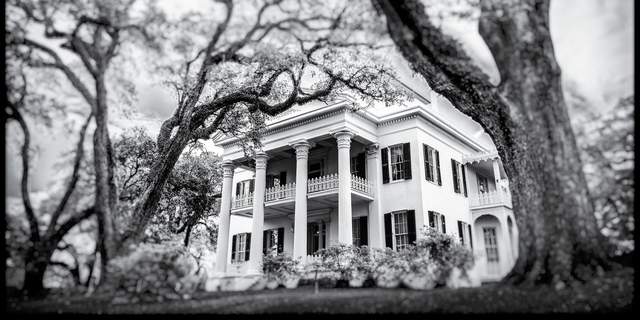Antebellum Houses of the American South: What Happens Now?
Published 5:47 pm Tuesday, May 18, 2021
The first time I went with Momma to look at white folks’ houses, it was her idea, and I didn’t want to go. I was 10, and she told my brother and me that we would like seeing all the beautiful Christmas decorations. That was the word she used: “beautiful.” All the lights. Trees. Fake candy canes and reindeer. I didn’t understand. There were people who decorated their houses just for other people to come look at?
What was so special about their Christmas?
We had our own. My brother and I had hung half-working spools of string lights around our whole house and on the oversize cedar that we’d cut from the woods on our own land with Grandpa. We had even gone up into Grandma’s attic for our favorite decoration: at three-foot plastic Santa Claus with a light bulb in his boots that didn’t work.
Everything they had looked new, and it all looked the same. The houses were the same, few colors and sizes. They all had the same mailboxes, lined up at the edge of a wide sidewalk.
Some houses kept things simple and neat, like my room. They had yellow string lights fixed in straight lines on every edge. Other houses were like Momma’s closet, small and big bulbs in all colors and shapes. Some sat still. Others blinked and moved like a song from the ’70s.
I remember sitting in the backseat with wide eyes.
“How they get it like that?” I think I asked.
The last time I went with Momma to look at white folks’ houses, it was my idea, and she didn’t want to go.
I had spent years as a sociologist trying to understand how places come to tell human stories. To do that, I started paying attention to the matter of things, like an archaeologist but of life on top of the ground. I started to see parts of the world around me as artifacts, their shapes and function clues about the society that made them. You can learn a lot about a neighborhood just from looking at how wide the streets are, or whether there are sidewalks. A zip code can offer a glimpse into a person’s future. The monuments we erect can offer a glimpse into how we want to remember our past. And a house is like an archive, each of its contents and specifications a unique trace of history. Looking at those things in that way had made me ask whether we can pick and choose which stories are worth telling about a place—and which to keep quiet about.
Asking that made me watch.
In 2015, I watched two Black women lead a movement to remove the Mississippi state flag—which at the time included a Confederate battle emblem—from the campus of the University of Mississippi. In 2017, I watched a group of mostly white men mob and march to protect a statue of Robert E. Lee on the campus of the University of Virginia. In 2020, I watched people from all walks of life topple monuments, like dominoes, in places like Maryland and North Carolina. I watched, wondering, but not about what tied these moments together. I wondered what set them apart. How do you decide what should stay up and what should come down?
Wondering that about those flags and monuments—all artifacts that are tied in one way or another to American slavery and the Civil War—made me think about antebellum houses. Monticello in Virginia, Belmont in Nashville, Nottoway in Louisiana, the dozens of houses that sit along the Georgia Antebellum Trail. What should happen to them? Should they stay up or come down?
To answer that, I had to learn.
I knew what antebellum meant, of course. It referred to the period between the American Revolution and the Civil War, when well over three million Black humans were forced to plant, die, and harvest a nation from the pillaged lands of Native people.
But antebellum houses? I would come to learn that when most people said those words together like that, they were talking less of human life plundered and more Gone with the Wind. They meant a collection of European architectural styles and design elements that became popular in U.S. architecture, especially in the South, roughly between 1800 and 1865: symmetrical building frames, columns and balustrades, porticos and cupolas, verandas and balconies, tall windows and high ceilings, elaborate doors and entranceways, and opulent interior design.
I would learn that about 6,000 of the houses built during the antebellum period are still standing, and that of those about 400 stand open to the public throughout the year, some for home tours and others as the centers of museums.
Should we look at antebellum houses as living parts of our collective history, like a piece of stained glass recovered from the 1963 bombing of Birmingham’s Sixteenth Street Baptist Church, or Emmet Till’s casket, or the iron shackle that once held the ankle of an enslaved person? If so, one argument goes, not only should the houses stay up; they should be preserved and protected.
Or should we look at the houses like we do other buildings with troubled histories, like those on university campuses that bear the names of slaveholders and segregationists? If so, an argument goes, we should leave them where they are and contextualize them: plaques, historical markers, and QR codes.
Or are the houses like other sites of mass human suffering, worthy only of the ruins that most have already become?
Perched on a bluff in a river bend where Mississippi and Louisiana touch, Natchez, Mississippi, has one of the largest concentrations of antebellum houses in the country. Since 1932, the owners have opened these houses to the public as a part of the Natchez Pilgrimage, today one of the largest and oldest home tours in the U.S.
I told Momma about this question—about what to do with these grand antebellum houses—and asked her to come to Natchezwith me.
“I want us to go look at some.”
“The plantation houses?” Momma repeated the question as she heard it, her voice sounding like what I already knew. She didn’t understand. There were people who kept their houses decorated like that just for other people to come look at? “What’s so grand about misery?”
Momma was born in Mississippi in 1958 and was raised by a Black woman who saw what white folks in Mississippi did to Black sharecroppers in the 1930s and Emmett Till in 1955 and Curtis Flowers in the 1990s and2000s. As a girl, Momma had been called all kinds of words that, if you wrote them down, you’d have to skip some of the letters. She had run from trucks and hid from white men in rail yards. As a woman, Momma had buried two Black husbands and raised three Black sons.
And she had worked. Her first job was cleaning windows at a white family’s house—one time, all day, for six dollars. Her 10th job was helping wash the backs and backsides of white folks as a homecare nurse—five years, for “money that was never my money…and never enough.” Her next job was cleaning the house of a white family who owned a regional chain of service stations that majored in Southern-style fried chicken. “Nine dollars an hour, six hours a day, three days a week. I worked for them for nine years.” Momma’s memory was as clear as the sky the morning we left.
While she drove and listened to radio static, then Motown, then soul, I paged through a short book about the houses we were going to look at. The book was Natchez of Long Ago and the Pilgrimage, written by Katherine Miller, the woman credited with starting the Pilgrimage home tour during her tenure as president of the Natchez Garden Club in the 1920s and 30s.
“Today, these old estates…interlace the town of Natchez,” she wrote. “There are no two alike architecturally. Distinctive features, wide verandas upheld by classic columns, beautiful entrance doorways set off by exquisite fan lights, spacious halls, spiral stairways, elaborately carved woodwork, and high-ceilinged rooms, bespeak legends of romance and notable events that have transpired within their walls.”
I knew Momma would rather using Barry White than hear me talk about a bad book, especially a bad book that talked like that—“bespeak”—and had words like “pickaninny” and “our negroes” in plain text, so I tried to let her be.
I read to myself. “For long years following the golden days of the Old South, their doors, like their stories, were closed books, but now, opened to the public during the annual Natchez Pilgrimage, they give visitors a vision that thrills and lingers.” I flipped and skimmed until I got to the 25th page, where I stayed for all eight miles that it took the long version of “Never, Never Gonna Give Ya Up” to fade into Al Green.
I read the caption out loud: “Miss Mimi Brown and Black Mammy at Linden.” Then I held the book up so Momma could see the picture: a white adolescent girl sits on the steps of an antebellum mansion in Natchez. A few feet away and one step above, a Black woman stands with her hand pressed against one of two Tuscan columns extending up from the edge of the porch. Looming behind the woman and the girl is an immaculate entranceway, and above them a balcony, and off to the side the pendant leaves of Spanish moss. The girl’s head and hair hold a circlet, the woman’s a head-wrap. The girl wears a white dress for a tea party, the woman a calico dress draped with a white apron for the girl mother’s kitchen, or cookhouse.
“A slave,” Momma said.
Enslaved person, I thought, before correcting my own correction out loud. “Or a servant,” I said. The photo wasn’t dated. If it was antebellum, Momma was right. If it was taken in the 20th century, perhaps I was.
“What’s the difference?” Momma asked earnestly.
A half-song later, I said with a half-laugh, “They got a bed and breakfast there now.”
About 1,500 people visited Natchez in the home tour’s inaugural year, 1932. Today, the town attracts more than one million visitors annually, making it and its encompassing Adams County one of the most popular destinations in the state. In 2013, county tourism topped $110 million and accounted for nearly one-fifth of local employment. That tourism imprint includes the Pilgrimage home tour, which now opens for a spring and fall season.
I began reading descriptions that I had transcribed from the websites of some of the houses: At the house called Monmouth, visitors should “expect gracious hospitality, luxury lodging, excellent cuisine, historic tours of the house, and a lovingly restored garden.” At Brandon Hall, “enjoy walking paths in the forest, visit the private cemetery, or picnic under one of the great live oaks.” At the Concord Quarters, you can “walk out the door and enjoy a song and sermon at one of the oldest, Primitive Baptist churches in the city.”
“Ha ha, shit.” Momma’s ultimate dismissal.
On the “About” page of the Natchez Pilgrimage Tours website, it is noted that the area was “occupied by the mound-building and sun-worshipping Natchez Indians for centuries before the French built a fort and established a settlement here.” Later, the invention of Eli Whitney’s cotton gin, “combined with the already established institution of slavery, revolutionized cotton production and brought great wealth to Natchez planters and merchants. Much of that wealth produced grand…estates ranking among the most beautiful in America.”
We talked, sang, and rode under the vibrant blue skies until the road bent into Natchez, and a green sign pointed us downtown. Just after the sign, we passed two Black kids walking under an overpass in a direction opposite ours. The GPS confirmed we were getting close.
“Which one is this one?” Momma asked as I repeated the directions from my phone.
“It’s called Hope Farm.”
We went to Hope Farm first because it had been the home of Katherine Miller when she first dreamed up the Pilgrimage in 1932. Built in the late 18th century, its low-pitched roof shows its Spanish influences and its columned front porch its Greek ones.
“This it? It’s just a bunch of weeds,” Momma said as we circled the driveway. There were no other cars, and no other people, and a few minutes after we pulled in, there was no us. We left relieved.
In the four hours it had taken to drive to Natchez, we had not bothered to talk about whether we would actually go inside any of the houses. I knew from how Momma had said “plantation” that she didn’t want to. She probably knew from how I stopped talking regular once we passed those kids walking under the overpass that I didn’t either. For her, going in the houses would mean bringing something painfully uncomfortable too close. For me, going under the overpass, seeing those Black kids—the first two people we saw in Natchez—walking the other way, felt too close. It meant Hope Farm was a few miles away.
After Hope Farm, we visited Stanton Hall, often referred to as the “most stunning” of all the antebellum houses in Natchez. It’s a registered National Historic Landmark. For $25, you can get a one-hour tour ($15 for children 12 and under), run by the Pilgrimage Garden Club.





